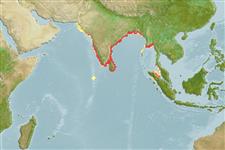Common names from other countries
Пластиножаберные (акулы и скаты) (sharks and rays) >
Carcharhiniformes (Ground sharks) >
Carcharhinidae (Requiem sharks)
Etymology: Lamiopsis: Etymology not explained nor evident, perhaps Gill thought L. temminckii resembled (-opsis, Greek for appearance) members of the family Lamnidae (Lamia = Lamna). (See ETYFish); temminckii: In honor of Coenraad Jacob Temminck (1778-1858), director of the Rijksmuseum van Natuurlijke Historie (Leiden, Netherlands), who “unlocked the treasures” (translation) of the museum during the authors’ visit in 1837. (See ETYFish).
More on authors: Müller & Henle.
Environment: milieu / climate zone / depth range / distribution range
экология
морской; солоноватоводный демерсальный; амфидромный (Ref. 51243); пределы глубины ? - 50 m. Tropical; 26°N - 2°N, 65°E - 100°E
Indian Ocean: records validated from India and Bangladesh. IUCN assessment needs to be revised for L. temminckii since L. tephrodes was resurrected from its synonymy (Ref. 84282).
Length at first maturity / Size / Вес / Возраст
Maturity: Lm ?, range 130 - ? cm
Max length : 160 cm TL самец/пол неопределен; (Ref. 121648); 208.0 cm TL (female); наибольший вес (опубликованные данные): 52.4 kg (Ref. 121648); наибольший вес (опубликованные данные): 52.4 kg
колючие лучи спинного плавника (общее число) : 0; колючие лучи анального плавника: 0. Grey or yellow-grey above, lighter below; no conspicuous markings (Ref. 9997).
A little-known shark found in coastal, inshore waters (Ref. 244). Probably feeds on small fishes and invertebrates (Ref. 9997). Viviparous (Ref. 50449). Not known to be dangerous to people (Ref. 244). Meat utilized fresh and dried salted for human consumption, liver for oil (Ref.244). Caught irregularly by inshore gillnet fisheries, particularly those operating off Borneo (Ref.58048).
Viviparous, placental (Ref. 50449), with 4 to 8 young per litter (Ref. 244). Gestation period of ~ 8 months (Ref.58048). Size at birth between 40 and 60 cm (Ref. 244). Distinct pairing with embrace (Ref. 205).
Compagno, L.J.V., 1984. FAO Species Catalogue. Vol. 4. Sharks of the world. An annotated and illustrated catalogue of shark species known to date. Part 2 - Carcharhiniformes. FAO Fish. Synop. 125(4/2):251-655. Rome: FAO. (Ref. 244)
Статус Красного Списка МСОП (Ref. 130435)
CITES (Ref. 128078)
Not Evaluated
Использование человеком
рыболовство: коммерческий
дополнительная информация
инструменты
Специальные отчеты
Скачать в формате XML
ресурсы в Интернет
Estimates based on models
Preferred temperature (Ref.
115969): 26.8 - 29.3, mean 28.4 (based on 172 cells).
Phylogenetic diversity index (Ref.
82804): PD
50 = 0.7500 [Uniqueness, from 0.5 = low to 2.0 = high].
Bayesian length-weight: a=0.00468 (0.00295 - 0.00741), b=3.08 (2.95 - 3.21), in cm Total Length, based on LWR estimates for this species & (Sub)family-body (Ref.
93245).
Trophic level (Ref.
69278): 4.0 ±0.61 se; based on food items.
устойчивость к внешним воздействиям (Ref.
120179): очень низкий, минимальное время удвоения популяции более 14 лет (Fec=4).
Fishing Vulnerability (Ref.
59153): Very high vulnerability (90 of 100).
